Slow Roast Beef
All right, the first important thing to know and understand about roasting meat is that it is easy. Generally, the less you fiddle with it, the better.
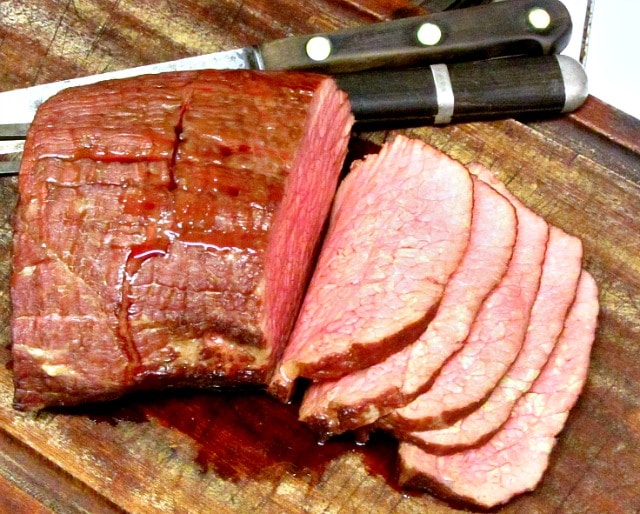
The second thing to know is that many people will try very hard to convince you otherwise. After all, how can I write a recipe if there aren’t Ingredients and Steps? How can you be impressed by your aunt’s holiday dinner if she didn’t slave over a hot stove? Besides, isn’t everything improved with more work? Isn’t More More? Surely… Well, you can season a roast, but the seasoning only flavors the very outside. It doesn’t make much real difference. You can marinate it, but that really works better with a flatter pot roast cut – something like sauerbraten – because again, the flavor doesn’t really penetrate. I’d rather cook it plain, and then offer sauces or condiments on the side – horseradish is great with beef – but we really just eat it plain, right away, and reserve seasoning for leftovers. We want the taste of the good food itself.
The third thing, and the most important, is that the only tricky part is timing, because (you’ve heard this chorus here before, sing it with me now) there are Too Many Variables. And that is part of the impetus to fiddle – the roast was dry so surely I need to Do Something Else. No – you need to be prepared to go with the flow, and accept that dinner is ready when the roast is, not at the time you set. If you roast the same kind of meat often, you will get a feel for timing for your oven, the size of roast you prefer, and so on, so it will get easier…
Now, some specifics. I am giving you here the slow roast method for the tougher (and less expensive!) cuts. This was eye of round – it’s also good for bottom round, rump roast, chuck roast. It’s not typically the method to use for the more tender (and expensive) tenderloin or rib roast – it will dry them out. (Though I understand it may be the best way to cook these cuts if you have grass fed meat, which is less marbled and less tender. I don’t tend to cook these cuts from any kind of cattle – so ask your butcher.)
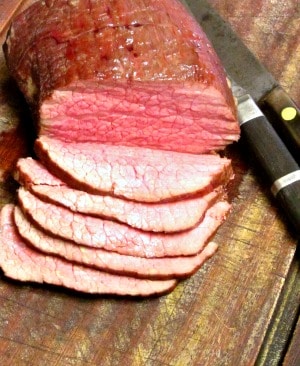
This also a very small roast. One mild frustration I have is that instructions for roasts usually happily tell you to take your four pound roast… and I may not want four pounds of roast beef for two of us! I may have bought a smaller piece to begin with (urban supermarkets, at least, often sell small roasts, appropriate for one or two. Being single should not doom you to a life without a nice dinner.) Or I may – as I in fact did – buy a larger piece, but then cut it – freeze some, brown some for later stew or chili, make a pot roast…
And that’s where the variables start. A smaller roast takes more time per pound than a larger one. A lean roast takes less time per pound than one with fat marbled through, as fat does not conduct heat well. Bones do, though, especially long thin ones, so they reduce cooking time. Ideally the roast should be at room temperature before you put it in the oven, but how many of us really can take the time to do that (aside from which ideally raw meat shouldn’t be sitting around at room temperature all that long anyway…)
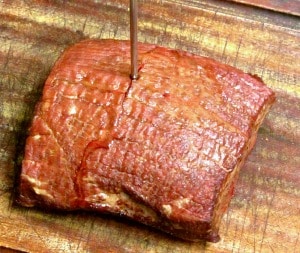
So you really need a thermometer. If you don’t have one, your supermarket should be happy to sell you one. When I was younger, you bought a Meat Thermometer which sat poked into the roast (conducting heat in, I may add…) and you peered into the oven and tried to read it. These days, they’re mostly Instant Read – open the oven, pull out the roast and close the oven (so it doesn’t lose heat) poke the thermometer in, read it, and go on to the next step. There are also fancy schmancy probes that you leave in the meat that will signal you when it reaches the desired temperature! I’m going to assume that if you have that, you don’t need me to teach you how to roast beef… But in general, the key here is the internal temperature of the meat – nothing else really matters.
I start with an optional step – a higher temperature to begin with. This helps brown the meat, speeds things up a little, and gives you something to tell the guest who is afraid that the lower temperature isn’t safe… It is, any bacteria on the outside of the meat (which is the only place they are…) are killed at 250°F – but starting at 325° sounds reassuring. And it gets the process going. You sometimes see directions to sear the meat at much higher temperatures – that does brown the meat nicely but also toughens and shrinks it, which isn’t really the goal.
You need to at least estimate the time. As a rule of thumb, remembering all the variables above, for rare beef it takes 40-50 minutes, 50-60 for medium, and 60-70 for well done (though really, with this cut and method, that’s likely to be dry and tough. If you want well done, I strongly recommend a pot roast instead.) And that’s *after* the preliminary 20 minutes – and then add 15-20 minutes afterward for the roast to rest.
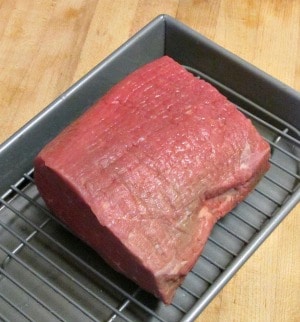
So – preheat your oven to 350°. Take out a roasting pan with a rack (which at this size can be a baking pan with a trivet.) You want the meat up on a rack with air circulating around it, not sitting flat in its juices steaming gently. Take your piece of beef and make a note of the weight. Pop it into the preheated oven and set the timer for 20 minutes. When it rings, lower the heat (without opening the oven!) to 250°, and set your timer for the shortest time you estimate.
At that time, take the roast out and check the temperature. Now, you want to allow for the fact that the meat will continue to cook as it rests… so take it out a few degrees short of the final temperature you want. For rare meat, that is 135°, for medium, 150°, for well, 160°, so take it out at, say, around 130° for rare, and so on. Then let it rest for 15 to 20 minutes, to reabsorb juices, so they don’t all gush out when you cut it and leave the meat dry. This is a great time to put the vegetables on, make gravy if you want it, pour the beverages… Then use a sharp knife to slice the meat very thin.
In fact, my example piece here was one pound, ten ounces, so quite small as roasts go. It is lean and compact, with no bones. I cooked it at 325° for 20 minutes, then at 250° for an hour and 20 minutes (50 minutes per pound) and took it out of the oven with an internal temperature of 135°. I let it sit for 15 minutes, then sliced – and got a lovely pink Medium rare roast beef. Somehow I didn’t get a picture of the juices that collected in the little cup on the carving board – that is the Jus, as in Beef au Jus, and I just poured it over the meat.
Perfection.
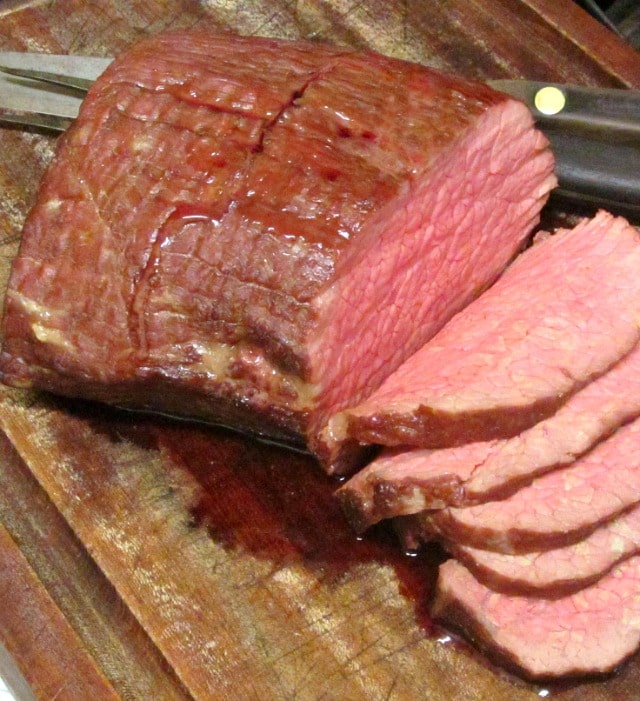

Slow Roast Beef
Ingredients
- 1-1/2 - 3 lb cut of less tender beef cut for roasting - round, chuck, etc.
Instructions
- Take meat out of refrigerator.
- Preheat oven to 325.
- Place meat on a rack in a roasting pan.
- Place in oven at 325 and roast for 20 minutes.
- Lower heat to 250. Roast until internal temperature is at the doneness you want - see post for details.
- Remove from oven, and let sit for 20 minutes to reabsorb juices.
- Slice thin and serve, with jus.

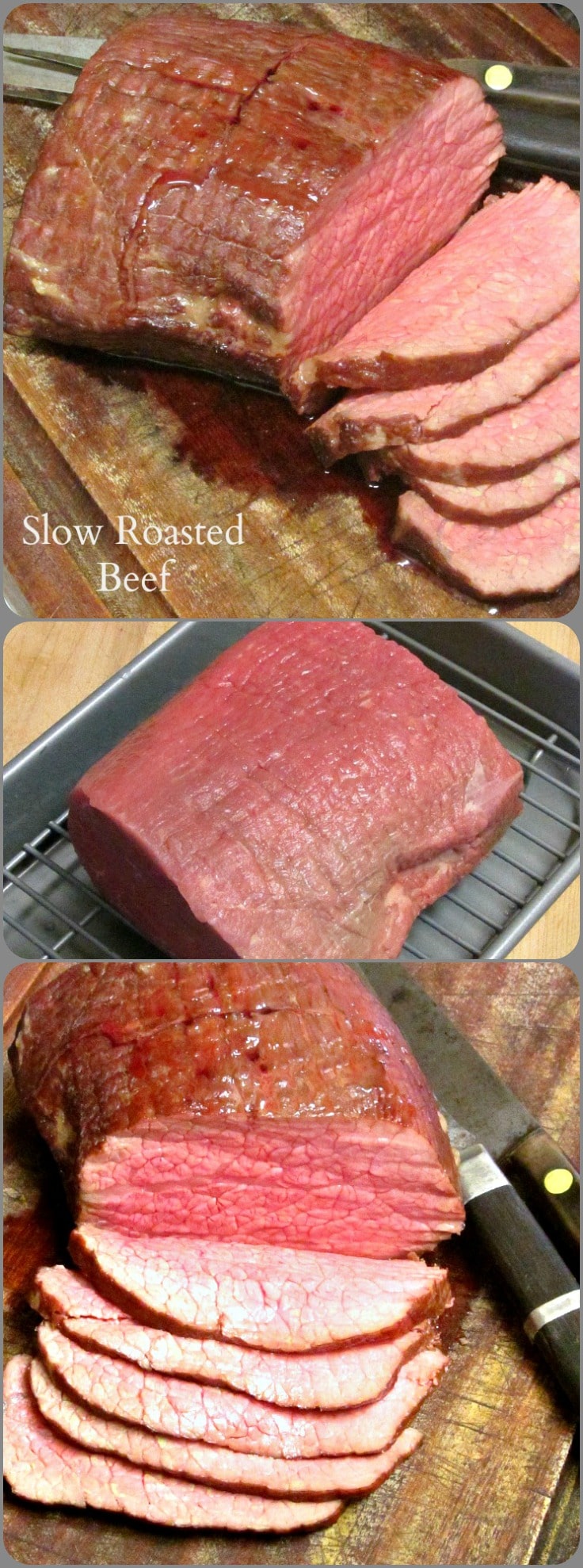
My boys would live this- what a great way to cook a less tender cut of beef It looks so juicy!
That’s one of the great things about this method (and be sure you do give it that rest when it comes out of the oven!) The meat holds the juices, so instead of a dry roast with lots of drippings, you get this lovely moist meat (and just a little jus…)
I hope you and they enjoy it!
I love roast beef! I always try to get all fancy and add a bunch of stuff, but sometimes the simple route is just the best. 🙂
Thank you!
You know, there’s a place for fancy treatments, but I’ve found that a belief that you need them is stopping many people from roasting beef (or other meat) at all. And that’s just too bad…
Looks great! Perfect for holidays and special dinners
Thank you!
And absolutely! But… because it really isn’t complicated, and uses an inexpensive cut, it’s also good for a classic Sunday dinner – something a little nicer than a weekday, but not too hard, and then sandwiches for lunch during the week. 😉
That is the most perfect looking roast ever! Excellent cooking method.
Thank you!
Great information on cooking instructions. It is so hard to get meat to the right temperature. Very useful post.
Thanks!
And it is All About internal temperature. One of the advantages of the slow roast method, I find, is that the timing is a little more flexible. Your roast won’t overcook if you get to the oven five minutes later than planned… which fits into Life a bit better, I think.
This roast beef looks delicious! Can’t wait to make it!
Thank you!
I’d love to hear how you like it!
Outstanding!
I had a 2-1/2 lb Rump Roast that worked great, Steaks are my choice, but the roast was a nice change. Thanks for such a great recipe. I will surly make it again.
Oh, I’m so glad you liked it!
Thank you for letting me know. I love hearing from people who have actually cooked the food!
I love slow cooked red meat. Beef and lamb get nice and tender when you slow cook it. This looks perfect and sounds so yum. Can’t wait to try.
i am very very new to the world of beef so i will have to refer back to this post when im making one, which will be soon 🙂
My mother would agree with you about just enjoying the flavor of good food and not covering it with spices until you’re having leftovers. These are great instructions to help ensure that the less expensive cuts of meat come out tender. I’ve pinned this to refer back to later.
I’ve not made a roast before so I appreciate all the useful information you shared.
I have never ever tried making roast beef on my own. I remember my mom making it a few times growing up, but it’s not something I ever learned to make. My husband would love this so I think I’ll have to try it!
What a great, unfussy way to cook a roast beef. This looks super tasty!
Thank you for such a thorough, helpful post! It really answered a lot of the questions I had about cooking roast! I agree about not always wanting a huge pot roast!
I completely agree with the idea of just enjoying the flavor of good food. Sometime simple is best! I also LOVE that you gave instructions to help ensure that the inexpensive cuts of meat come out tender. Pinned!
I just got into slow roasted beef roasts and it’s the best thing ever! I love to make a spice rub to give it extra flavor. Can’t wait to share this one with the hubs!
I love your simple approach to roasting beef. I definitely agree, sometimes the simple things are the best. Thanks for the great instructions!
This looks like the perfectly cooked roast, and you make it sound so easy. Thanks for sharing your tips!
I completely agree–there’s really no substitute for a good kitchen thermometer! It just makes things like telling when a cut of meat is done SO easy, and removes so much of the uncertainty that drives me nuts otherwise. This is a great guide!